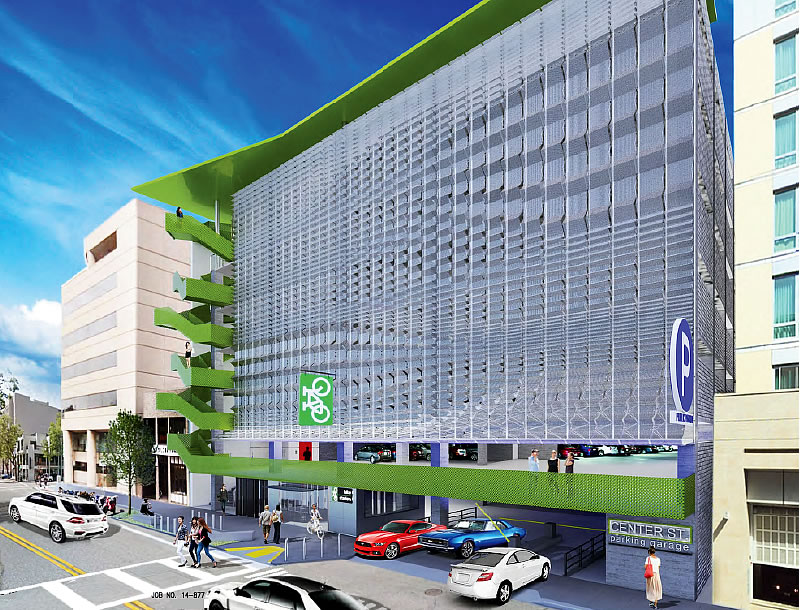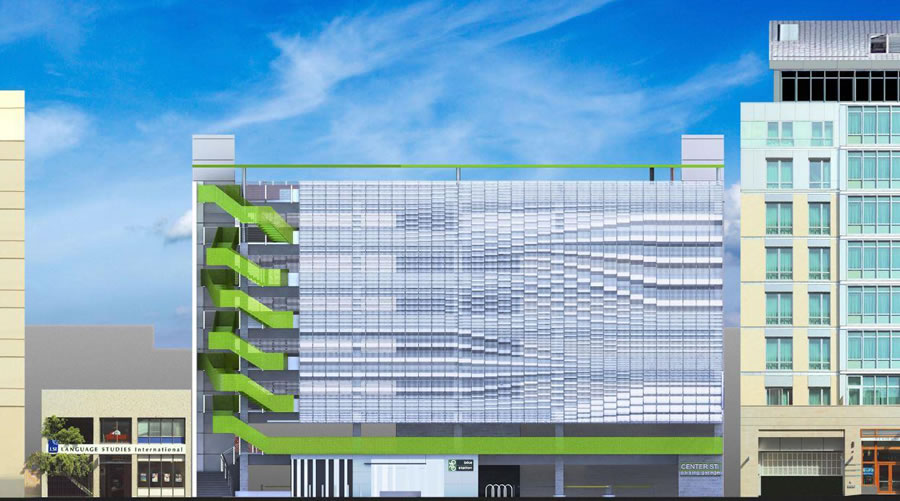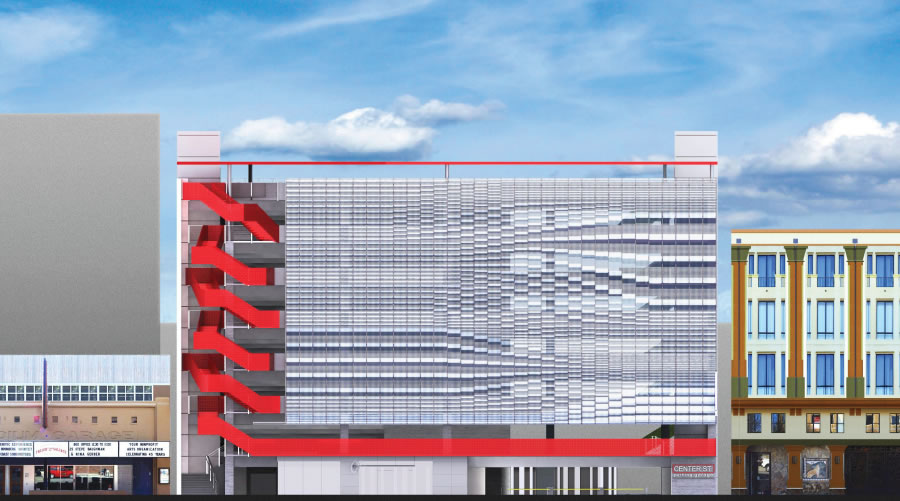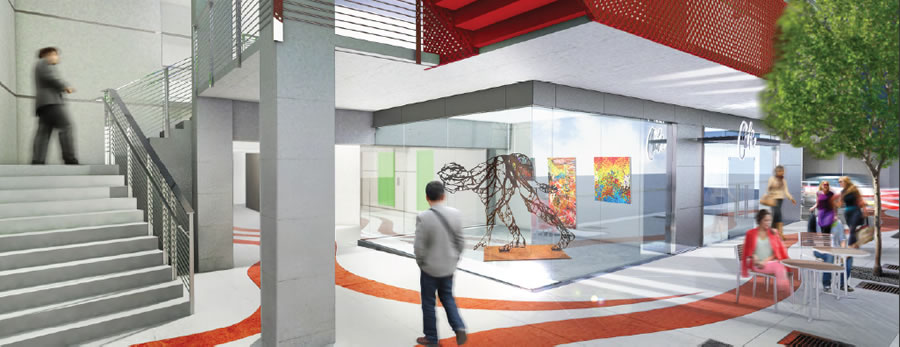If approved this week, the five-story, 440-space Center Street Parking Garage at 2025 Center Street in Downtown Berkeley, which is owned by the City, will be razed and an eight-story, 711-space replacement garage will rise upon the site.
The proposed structure includes a new location for the Downtown Berkeley Bike Station, which would move from Shattuck Avenue, with valet parking for around 270 bicycles and 640 square feet of retail space for bike repairs, accessories sales and rentals. An adjacent area with 56 spaces for BikeLink pass holders would be managed by the Station as well.
Along Addison Street, which the structure also fronts, a small retail space is intended to be occupied by a quick-service restaurant or cafe with an adjacent 285-square-foot area for art.
A 7,500 gallon cistern would be installed at the ground level to collect rainwater for irrigation purposes and Photovoltaic solar panels would be mounted above the parking spaces atop the building.
The garage includes 24 electric vehicle (EV) charging spaces with conduits pre-installed for an additional 33. And if approved as proposed, the demolition of the existing garage and construction of the new parking structure will take around 12 to 14 months to complete.




Nice! We need more of these in our parking deficient neighborhoods in San Francisco.
For example: Think of what this could do in the Valencia St. corridor:
1. Remove all street parking from Valencia.
2. Wider sidewalks, more street landscaping, more green space.
3. protected bike lanes.
4. More pedestrian friendly.
Great Suggestion.
Unfortunately, this goes against those activist voices, with vehement anti-car dogma, who want everything bicycle only.
Given the zero interest in real transit investment in this town, parking structures that are aesthetically pleasing should be built in most SF neighborhoods.
Because there is so much excess road capacity in most SF neighborhoods to support all the cars parked in such structures?
Ah, but once we build lots of parking structures, we can turn all the small streets into mini-highways, by eliminating the parking lanes!
Totally agree with Futurist on this.
add me to the mix with agreement that we need more parking structures. If SF wont invest in real transformative public transport, then we should make it easier for people to get their cars on and off the street ASAP to ease congestion
I would even go so far as to say, with a well designed parking garage like this, Valencia Street could become and entirely car-free pedestrian zone; Much like the 3rd St. promenade in Santa Monica.
We would have to deal with delivery issues and timing, but that could be solved. Think of the possibilities.
We can learn from some of the great European car free streets, by adding large parking garages at several corners, incorporating housing as well.
hmmm…maybe. As I’m sure you know we have a bad history of pedestrian malls in this country. Yes, 3rd Street promenade works. But there were also tons of them put in the 70’s around the country that were torn up in the 80’s and 90’s. Valencia actually works very well now…(particularly the part that was rebuilt)..there is tons of pleasant sidewalk space, bike lanes, bike parking, and a lane of traffic in each direction with turn lanes at the corners. I see no reason to change it. I’m not opposed to neighborhood parking garages…I think they could serve a real use for residents and visitors….although I’m increasingly feeling that the most affordable answer is uber/lyft/taxi for those times when walking or biking don’t work (for those who don’t need a vehicle for work).
Valencia sorta works, except there are cars in the bike lane everyday. And I was hit (and run) on my bicycle by a driver on Valencia at 17th once when trying to get around a car parked in the bike lane. We need to get rid of that center lane and protect the bike lanes; make sure there are safe drop off areas for uber/lyft/taxis. Then it’ll be perfect!
I’m a huge fan of structured parking as an alternative to curb cuts and driveways and individual garages. Let’s separate the markets for car storage from homes for people.
Good point about the bike lanes..the biggest conflict on Valencia right now is with double parkers in the bike lane. Sorry you got hurt!
There’s a difference between a pedestrian mall which is basically taking a 20th century street and closing it off from traffic to building a network of narrower, pedestrian-friendly walkways and alleys. Covent Garden comes to mind.
Yes there is, But remember London is centuries older than we are and their random, small, curvy streets began way before we were even populated essentially.
I don’t think SF is about to build a new network of ped friendly walkways and alleys. After all, we have an existing street grid and existing structures that are largely here to stay.
But I do feel that Valencia has the possibility of becoming a pedestrian only street, perhaps a few blocks; with the parking issue solved by a garage and other logistical issued addressed. Trouble is, it would NOT work if cyclists were allowed to continue down Valencia. So, yea, there are challenges.
SF already has much larger sidewalks than the premier cities in EU
One of the differences between the 70s pedestrian malls, I think, is that they were built as a reaction to the decline of central cities and pedestrian culture, as a way to reinvigorate it. They were going against the current, and they failed. In SF today, it’s the opposite– we have no shortage of people wanting to come here, with or without cars, and so pedestrianizing streets is a reaction to built-up demand, so it should be much more successful.
Denver did this downtown. Except they put in 2 protected bus lanes in and made the buses free (I think.) It’s one of the nicest downtowns I’ve ever been to – enough to make me jealous. Then again, they also started heavily enforcing homeless laws as well.
Sounds good in theory, but in practice even existing garages don’t get full. You’ll get opposition which will say this is a money grab, that some people can’t walk even one block to their store, that people need to load and unload in front of every store, that their employees will no longer be able to afford to park to work, etc.
I’ve heard it all with SFPark and I have no confidence that a garage will magically allow to strip out all the parking on Valencia. I do think that we should require removing one on-street space for any in-garage space created though. That could gradually achieve what you’re suggesting.
Sebra Leaves et al would certainly foam at the mouth over it.
Great suggestions for Valencia Street, especially if it becomes a less congested street for pedestrians and bicyclists. European downtowns have made great strides to improve their old, central squares and main streets by removing all surface parking from certain streets/squares and replacing it with underground parking. The quality of life drastically improves and it has helped to revitalize downtown streets and neighborhoods, by making them peaceful places to stroll, shop, dine, barhop… I agree with your suggestions for a car-free Valencia Street, too.
Where, exactly, would you put new parking structures in San Francisco? And wouldn’t that land be better used for housing, given the current crisis?
Well, as an example: the recent gas station corner lots on Valencia could have been built with a parking garage below AND above grade for a few floors, and THEN have 4-6 floors of housing on top of it.
So, a 7-10 story building above ground? We don’t even allow that for housing, because of shadows or neighborhood character or something, but it would be ok for a parking garage!?
The way it’s been done in many European downtowns/central squares is beneath the street. Subterranean garages are hugely expensive and their construction is very disruptive (imagine some sections of Valencia Street dug up for months or years). As much as I’d like to see at least a few blocks of Valencia be car-free, it’s a heavy price to pay if the trade off is very disruptive construction. And if public money is spent digging underground infrastructure, we’d all be better off if it was spent on subway construction.
Does anybody know why places like SF and Berkeley have not adopted those automatic rotisserie style parking garages that park cars for the owners, thus eliminating all the circulation space? It seems like in SF, narrow lots on each block could be turned into these parking facilities, where spaces could be leased to all the residents on the block.
Dude, *exactly* was I was going to note – Berkeley could build a structure half this size and park just as many cars by using lifts and turntables. I’m not against increased parking per se, but this is an ugly monstrosity for a downtown (or anywhere), which need not be the case at all.
Just to be clear, whether the developer would choose to use an automatic parking system or not, does NOT, in itself have anything to do with the exterior design, massing, design image at all. Is it just because you don’t like parking garages at all?
Calling it an “ugly monstrosity” is probably because you don’t like the design. period. BTW, I think it’s a pretty fresh, interesting, artful, colorful façade.
Please let’s not have this argument again. Not in front of the kids…
Not sure there is an argument at all. You just don’t like it and I do.
This garage serves the Arts District downtown (read: theatergoers who leave in mass after a performance). Lifts and turntables would not work in this situation.
What makes you think the residents are willing to pay? People object to even $100 a year for parking permits– I don’t see them lining up for the tens of thousands a parking structure would surely cost.
This will be a great improvement to the downtown area. The current structure is rather shabby and the lack of sheer walls make it seismically deficient.
Very good idea.
The double helix design is pretty cool. You have, essentially, two separate garages — one with a north ingress/egress point and one with a south ingress/egress point. You could enter one garage from the south entrance, drive all the way to the top, and then drive down the other garage and exit to the north. The neat trick is that you can cross between the two garages at the midpoint of every level (think of the ramps crossing each other like an X). That means, when exiting, if there is a back up, you can switch to the other garage’s exit any point where there is a crossover. This is especially relevant to the theatergoers in the evening after a performance gets out and everyone is trying to leave.
The proposed bike parking is the same size as the existing bike station on Shattuck, except that the balance is being shifted away from 24-hour-access Bikelink in favor of business-hours-only valet parking. Given that the existing bike stations at Berkeley and Oakland fill up by 9am, wouldn’t it make sense to increase capacity?
I use the downtown Berkeley bike station. The valet side is always filled, while on the self-park side I’ve rarely seen more than 20 bikes.
Of course. The only reason to use the self-service side is if you need late night access. The valet service is better in all other ways, and doesn’t cost anything.
What a disaster! More parking = more driving = more pollution, collisions, greenhouse gas, etc.
I thought Berkeley was progressive but it is actually turning into Emeryville.
I agree. Now is not the time to be adding parking.
While I agree with some of your points, let’s not get histrionic here. Berkeley would love to have Emeryville’s sales tax revenues, but there is only so much Generica Big Box Retail to go around. 🙂
Clearly removing parking is not working, so it’s not a bad idea to try some different. Only problem will be where will the cars park during construction?
Good idea. More parking to relieve congestion instead of less, because removing it has not worked very well. We have been advocating for parking garage hubs in San Francisco for a while now. Berkeley can show us the way to do it. Maybe the tech buses, that must also plague the East Bay, since some cross the bridge, can be forced to do their pickups and drop-offs there as well.